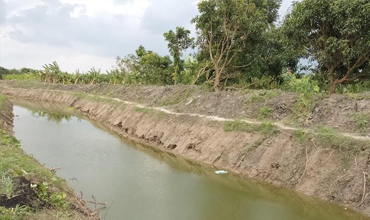
Surface water irrigation yields 42,000 tonnes more crops in Rajshahi
RAJSHAHI, March 9, 2023 (BSS) - The surface water irrigation has been yielding around 42,000 metric tons of additional crops annually in the region, including its vast Barind tract, for the last couple of years.
The additional yield is being produced after bringing around 55,000 hectares of land under irrigation using conserved rainwater in the region.
The Barind Multipurpose Development Authority (BMDA) has re-excavated khash canals and ponds for rainwater conservation to extend irrigation facilities in this drought-prone Barind area.
BMDA Superintending Engineer Shibir Ahmed told BSS that the five- year project titled "Barind Rainwater Conservation and Irrigation" has been implemented in nine districts under Rajshahi and Rangpur divisions costing around Taka 238.95 crore recently.
Under the project, 900- kilometer canals, 700 ponds and nine other water bodies were re-excavated with constructing 212 water control structures and two rubber dams to promote irrigation to the farming fields.
Besides, 100 dug-wells were excavated to provide drinking water to the poor people coupled with creating supplementary irrigation facilities.
On behalf of the project, three lakh fruit plant saplings and six lakh forest and medicinal plant saplings were transplanted to create additional forest resources for developing the environment and socio-economic condition of the people.
It has also created employment opportunities for the day labourers and marginal farmers in agriculture improving their living and livelihood conditions through additional crop production.
As a whole, the scheme has been playing a vital role towards boosting surface water uses for irrigation purposes round the year apart from improving the environment here, a common concern of the area.
"We have scopes of enriching the surface water resources after proper retention and conservation of rainwater through re-excavating the existing derelict ponds and canals," said Ahmed.
He said more use of surface water for irrigation has become an urgent need following abnormal lowering of groundwater table especially in high Barind tract comprising 25 upazilas of Rajshahi, Naogaon and Chapainawabganj districts.
The BMDA, a state-owned organization, has decided to check any more installation of deep tube wells (DTW) to control the lowering of underground water tables.
Jahangir Alam Khan, Coordinator of Integrated Water Resource Management (IWRM) Project, said there are enormous prospects of boosting irrigation by surface water in the barind area as it has scores of natural water bodies which remain in uncared and derelict condition at present.
He said inadequate rainfall has been escalating the crises in the region for the last few years.
Khan said they are motivating and encouraging more than 12.58 lakh community people of 2.66 lakh households towards promoting and using the surface water resources to reduce the pressure on underground water under the IWRM project.
The IWRM project is being implemented in around 1,280 drought-hit villages under 39 union parishads and three municipalities of eight upazilas in Rajshahi, Naogaon and Chapainawabganj districts since 2015 supported by Switzerlands.
Khan mentioned that there are around 10,000 ponds, 200 canals and ten other big sized water bodies in the barind areas including Beelbhatia, a vast water body and wetland of around 6,388 acres, at Bholahat upazila in Chapainawabganj.
Tens of thousands hectares of farmlands can be irrigated round the year through using conserved water of the beel if it is re-excavated.
There is another four to five kilometer long water body at Rohanpur in Gomastapur upazila of the same district. If it is re-excavated, around 10,000 hectares of land of 25,000 farmers can be brought under surface water irrigation.
Apart from this, the two-kilometer Chowdala-Boalia canal remained in derelict condition for a long time. Around 150 hectares of farmlands can be irrigated with water from the canal if it is renovated.
Surface water irrigation can be crucial in lessening the gradually mounting pressure on groundwater Khan said.





